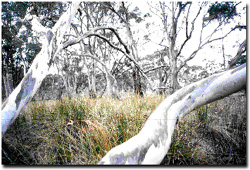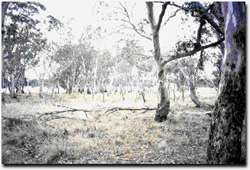Site 6 - Archdale Reserve
Site of uncertain environmental stability but visibly salt affected
Description
Archdale Water Reserve (Streamside Reserve-Parks Vic) previously had been licensed for grazing (Stimson, May 1998).
The area is adjacent to the Avoca River on an alluvial plain at an altitude of 200 m. The area to the west rises to Palaeozoic sediments. The riparian vegetation is linked to adjacent Eucalyptus leucoxylon (Yellow Gum) Open Woodland giving it potentially high habitat values. This has been reduced to a moderate value with understorey invasion and competition with weeds in the riparian zone and grazing in the adjacent Yellow Gum Woodland.
| Vegetation Composition This riverside reserve is dominated by Eucalyptus camaldulensis (Red Gum) Riparian Woodland EVC, transitioning into Alluvial Terraces Herb Rich Woodland Eucalyptus leucoxylon (Yellow Gum) on the higher ground. The understorey is predominantly members of the Poaceae (grasses), Cyperaceae (sedges) and Juncus (rushes) families. Some areas now have 50% introduced species, mainly members from the Poaceae Family. There are two salt indicator species present Juncus acutus (Spiny Rush) and Lolium sp. (Rye grass). There appears to be minimal change in the vegetation survey results beyond the recent loss of Triglochin procera (Water ribbons) and several members of the Asteraceae family, due to the continued dry conditions. |  Riparian Woodland vegetation directly adjacent from the Avoca River |
 Alluvial terraces herb rich woodland on higher ground parallel to the river | Tree Health Eight trees are monitored for tree canopy health using a 20-point system assessing canopy size and density, number of dead branches and extent of epicormic growth. Leaf damage by insects is also assessed. Most trees have experienced decline in canopy cover and density since 1997. Some trees also contain large amounts of epicormic growth and evidence of insect attack. These results could be due to dry conditions and need to be compared with further data collected in seasons of above average rainfall. Groundwater and salinity There are three bores located near the site and demonstrate a strong interaction with the level of water in the Avoca River. The groundwater is highly saline with all bores recording >10 000 EC in 2002. The hydrographs indicate that the site experiences localised recharge in response to river levels. Groundwater and river volumes have dropped in response to dry seasonal conditions. The vegetation straddling the Avoca River is visibly salt affected. |
Birds
Bird species seen at the time of vegetation and tree health surveys include:-
Brown Treecreeper, Galah, Magpie, Rainbow Bee-eater, Red-rumped Parrot, Red Wattlebird, Superb Fairy-wren, Welcome Swallow, White-plumed Honeyeater, Black duck, Noisy Miner and Willie Wagtail.
Threats to the site continue to be:
- Weed invasion particularly Juncus acutus (Spiny Rush) and Phalaris spp (Canary Grass).
- rabbits
- pooling of water in Avoca River and flood debris on quadrat
- possible bank erosion
- rising groundwater and salinity levels
- possibility of sheep being driven through the Reserve


